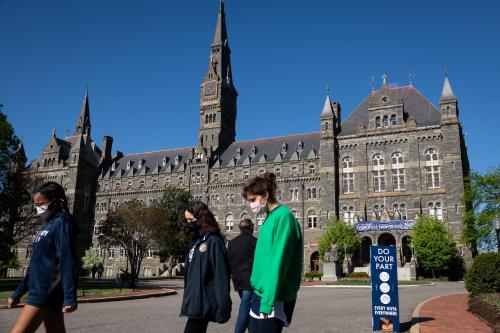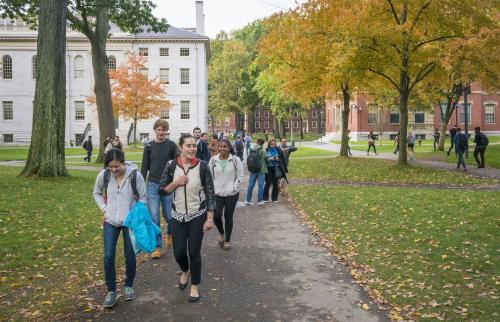A handful of mostly private four-year colleges and universities have massive endowments, measured in the billions of dollars. They have been compared in magnitude to the GDP of many countries. Those funds are invested aggressively to generate the largest possible returns. Critics have labeled these institutions as “hedge funds that have a university.”
Such concerns led to the introduction of a tax on highly endowed colleges and universities. As part of the Tax Cuts and Jobs Act (TCJA) in 2017, colleges and universities with more than 500 students and endowments larger than $500,000 per student are now required to pay a tax of 1.4% on the total income from their endowments. In 2021, 33 schools were subject to this tax—a tiny fraction of the American higher education sector but one that receives considerable public attention. Proposals to extend the endowment tax to more institutions and increase the tax rate have proliferated recently.
Unlike hedge funds, though, colleges and universities have a clear and broad focus on benefiting society. Opponents of the endowment tax argue that these large endowments help these institutions accomplish that mission. They provide vast resources that enable them to provide a high-quality education, which allows graduates to benefit society through their innovation, entrepreneurship, and leadership. Research conducted at these institutions offers considerable public value. Those funds also provide extensive support for financial aid. If these benefits are sufficient, then such a tax is unwarranted.
A critical component of this debate is the extent to which large endowments benefit low- and middle-income students. If highly endowed colleges and universities use that money to lower the cost for these students and enroll more of them, it would promote social and economic mobility, which is limited in the U.S. If so, taxing large endowments would be less desirable. But if these institutions are not accessible to these students, then the benefits of their endowments would accrue more to the children of the affluent. That would strengthen the case for taxing them.
This report assesses these arguments for taxing highly endowed colleges and universities. Initially, I provide an overview of how endowments affect institutional finances. How much of that money can schools spend? Then I consider the objectives in spending the available funds. What should such spending accomplish? Finally, I document how that money is spent. Do these institutions spend more on their students and do they use those funds to improve access?
Overall, I find that highly endowed institutions provide their students with a very high-quality education. This includes those from lower- and middle-income families who pay low costs when they enroll. The doors newly opened to these students represent an important social benefit.
But that doesn’t happen enough at these institutions. It is difficult to determine how many lower- and middle-income students are “enough,” and the share of such students has been increasing somewhat in recent years. Nonetheless, there is room for continued improvement. Further progress in expanding access to colleges with the most resources would be desirable. It would also weaken support for an endowment tax. This record should be factored into the debate.
Most college endowments are small, but a few dozen are very large
Only a handful of colleges and universities have huge endowments.1 For the purposes of college operations, it is the endowment per student (“full-time equivalent”—FTE—enrollments) that matters. Figure 1 displays the 2021-2022 distribution of endowments per FTE separately for public and private institutions. All dollar values are adjusted for inflation (2023$ using CPI-U).
These distributions are incredibly skewed. Most public institutions hold endowments that are under $25,000 per FTE. Just a few are larger than $100,000 per FTE. In subsequent discussions, all public institutions will be combined and considered to have small endowments.
Even among private institutions, only a minority have large endowments. There are 613 private colleges and universities in this category. Of those, 127 have endowments between $100,000 and $500,000 per FTE and 38 have endowments greater than $500,000 per FTE. The latter group is listed in Table 1. These 38 institutions enroll roughly 150,000 students per year. This number reflects around 1.5% of the 10 million students enrolled at 4-year public and private non-profit colleges and universities nationwide.
How much can institutions responsibly spend out of their endowments?
Endowments reflect the stock of accumulated financial assets that colleges and universities have. The income generated by those assets can be used annually to support current operations. Spending “too much” from the endowment would deplete those funds and limit subsequent uses. Yet the list of wants exceeds available funding even for institutions with vast resources, and they need a mechanism to set a sustainable level of endowment spending.2
Endowment spending philosophy often relies on the notion of intergenerational equity. What is available to students today should be available to students tomorrow. It assumes the institution will exist in perpetuity. Spending levels should be set such that the level of funding could be available forever, adjusting for inflation.
Setting that spending level requires making a set of assumptions. The first one is the current rate of return on long-term investments. A common assumption for that value is 7.5%. We also need to factor in an assumed rate of inflation, since the price of the goods and services that colleges and universities consume each year will likely rise. A reasonable assumption for that rate given the nature of goods and services that colleges and universities consume is 3%. Based on those values, colleges could safely spend 4.5% of the endowment each year, on average. That will generate a flow of constant purchases from those funds over time. That value is consistent with typical spending rates observed at highly endowed colleges and universities in the recent past.
At that rate of spending, an institution with an endowment of $100,000 per FTE would receive $4,500 per year in endowment support per student. This is a sizable amount of money and certainly of considerable value to the institution. But relative to the expense of running a college or university, it is not a large amount. Institutions with endowments below that level—which includes most four-year colleges—are relying primarily on other sources of revenue. Public colleges and universities also receive direct funding from states. Private colleges in this group are highly tuition dependent. They will struggle to provide affordable pricing for lower-income students. Where will the money come from to pay the bills?
On the other hand, the 38 private institutions with an endowment per FTE of greater than $500,000 would receive a payout of more than $22,500 per student (see Table 1). They could spend much more educating their students. They also have the option of reducing costs for lower- and middle-income students substantially. A few colleges have endowments of $2 million per FTE or more. They have access to around $100,000 or more of additional funds per student.
Colleges face a trade-off between excellence and access in spending endowment income
The extent of financial support that endowments provide to these select few institutions gives them the luxury of options regarding how to spend those funds. What goals should they prioritize in making those spending decisions?
All colleges and universities seek to provide their students with a high-quality educational experience. Research universities also seek to make contributions through innovation. They seek to accomplish these goals through the faculty they hire, the academic program and research experiences they offer, and the facilities they maintain, among other things. Such extensive resources enable highly endowed colleges to strive for “excellence” in a way that is difficult for others to match.3
These institutions also benefit when they provide greater access. Improving society is part of their mission and society benefits when high-achieving students live up to their potential, regardless of their financial status. Students from disadvantaged backgrounds benefit more from attending these institutions compared to their more-advantaged peers. Greater access also brings a greater range of voices to campus and to the classroom, which benefits the broader college community. And higher-income students who pay the full sticker price may prefer to attend colleges that offer greater socioeconomic diversity. Funds available from the endowment enable institutions to lower the price they charge lower- and middle-income students to an affordable level.
Both goals cost money. Striving for excellence is expensive. Offering affordable pricing has an opportunity cost. Ultimately, excellence and access are both important goals that need to be delicately balanced.
Both public and private institutions face this trade-off, but they are likely to weigh the factors differently. Access is a core part of the mission at public institutions: they are funded by states to educate the populace at large, not just the wealthy. Private institutions value access as well, but it is less fundamental to their existence. One may not expect enrollment rates of lower- and middle-income students at these private institutions to match those at public institutions.
Colleges with large endowments spend much more on students
For the purposes of this exercise, I focus specifically on spending directly on students, which I define as spending in the categories of instruction, academic support, and student services.4
The results presented in Figure 2 show dramatic differences in such spending across institutional categories. Highly endowed private institutions spend around $60,000 more per student than public or tuition-dependent private institutions. This gap is roughly consistent with the gap in simulated endowment spending per FTE. The level of spending at these institutions averages $76,000 per student—greater than the level of tuition and fees (omitting room and board) they charge even to students receiving no financial aid, around $60,000. Even the highest income students are subsidized by these endowments.
Lower-income families pay lower prices at colleges with large endowments
Extending previous research, I find that highly endowed private institutions charge students from lower- and middle-income families less than elsewhere. Students at the 25th and 50th percentiles of the income distribution (with typical assets for these income levels) have incomes around $40,000 and $80,000. As shown in Figure 3, students from families with incomes of $40,000 are estimated to face a net price of $6,600 at highly endowed institutions. At roughly the median income level ($80,000) they would pay $14,800 per year.
Other categories of institutions charge these students more. At public institutions, these students would pay $15,600 and $22,900, respectively. Private institutions with small endowments charge these students the most. With limited endowment support and no direct state funding, they simply can’t afford to charge them less.
It is not until students’ incomes surpass perhaps $100,000 to $125,000 (with typical assets) that they face a higher net price at highly endowed institutions than they would at public institutions. At an income around $200,000, tuition at highly endowed universities becomes more expensive than less well-endowed private institutions as well. Even at that point, students at highly endowed institutions pay less than the full sticker price, which is the cost figure that often gets the most public attention. Only those with even higher incomes pay the full sticker price.
Recent evidence documents that the socioeconomic circumstances of enrolled students at elite colleges and universities are heavily skewed towards higher-income families. Tracking changes over time at these institutions, though, is more difficult. The easiest measure to use for such purposes is the percentage of students that receive a Pell Grant. These federal awards are provided to students whose family incomes are perhaps at the 40th percentile of the income distribution or below.5
Figure 4 displays the trend in the percentage of students receiving Pell Grants by category of institution. Pell Grant receipt is the lowest at highly endowed private institutions. Fewer than 20% of their students receive Pell Grants. At public institutions over one-third of students do so.
Lower-income students may have lower enrollment rates at private institutions because they face challenges specific to their socioeconomic status. This includes less access to high quality preschools, weaker K-12 education, fewer resources available for tutoring, and a range of other factors. Overcoming the high admissions standards imposed by these institutions may be more difficult for them.
But past research suggests that isn’t a sufficient explanation for low enrollment rate of lower-income students at prestigious universities. There are a substantial number of lower-income students who “undermatch” with the colleges they attend (meaning they had strong academic backgrounds, but they attended less competitive institutions). This pattern was described in research that received considerable attention after it was released in 2013.
It is noteworthy that the share of Pell Grant recipients at highly endowed colleges and universities rose immediately following the release of that research. Pell Grant receipt at these institutions stood at a level of 15.6% in 2014-2015. By 2021-2022, 18.1% of students at these institutions received Pell Grants. It is the only category of institutions where that level is rising.
Highly endowed colleges benefit the public, but should do more to improve access
Highly endowed colleges spend much more money educating their students than those with more limited resources. That is certainly in the interest of those students. Their graduates also have the opportunity to use their high-quality education to help improve society.
Highly endowed institutions can also contribute to society by promoting social mobility. They are able to provide extensive financial aid to lower-income students, providing them with access to the life-long benefits of a high-quality education at a low cost. This can help close the socioeconomic gap between students from lower- and higher-income families.
These institutions need to take further steps designed to enroll a larger share of these students. Many have implemented policies to further reduce the cost. They have implemented “no-loan” policies, eliminated expectations of student employment, and have instituted pricing systems that go beyond meeting full need. Greater transparency that would better communicate their pricing policies and exploring other approaches to further extend their recruitment efforts would be helpful. Favoring socioeconomic status in the admissions process may also represent an element of their response to the recent prohibition of race-based affirmative action.
The impact of ongoing efforts is still to be determined, but the goal of greater access is a meaningful one. Failure to make continued progress in this realm would enhance the justification for an endowment tax.
Appendix
|
Rank |
Institution |
Endowment per FTE |
"Endowment spending" per student |
|---|---|---|---|
|
1 |
Princeton University |
$4,600,000 | $207,000 |
| 2 | Yale University | $2,650,000 | $119,000 |
| 3 | Massachusetts Institute of Technology | $2,330,000 | $105,000 |
| 4 | Stanford University | $2,230,000 | $100,000 |
| 5 | Harvard University | $2,040,000 | $92,000 |
| 6 | Swarthmore College | $1,800,000 | $81,000 |
| 7 | Amherst College | $1,740,000 | $78,000 |
| 8 | Williams College | $1,660,000 | $75,000 |
| 9 | Pomona College | $1,640,000 | $74,000 |
| 10 | Grinnell College | $1,610,000 | $72,000 |
| 11 | California Institute of Technology | $1,580,000 | $71,000 |
| 12 | Bowdoin College | $1,480,000 | $67,000 |
| 13 | University of Notre Dame | $1,390,000 | $63,000 |
| 14 | Dartmouth College | $1,300,000 | $59,000 |
| 15 | Wellesley College | $1,200,000 | $54,000 |
| 16 | Berea College | $1,060,000 | $48,000 |
| 17 | Washington and Lee University | $1,010,000 | $45,000 |
| 18 | Rice University | $990,000 | $45,000 |
| 19 | Claremont McKenna College | $960,000 | $43,000 |
| 20 | Vanderbilt University | $910,000 | $41,000 |
| 21 | Duke University | $900,000 | $41,000 |
| 22 | University of Richmond | $880,000 | $40,000 |
| 23 | University of Pennsylvania | $870,000 | $39,000 |
| 24 | Smith College | $850,000 | $38,000 |
| 25 | Emory University | $780,000 | $35,000 |
| 26 | Washington University in St Louis | $780,000 | $35,000 |
| 27 | Bryn Mawr College | $740,000 | $33,000 |
| 28 | Trinity University | $730,000 | $33,000 |
| 29 | Davidson College | $720,000 | $32,000 |
| 30 | Hamilton College | $670,000 | $30,000 |
| 31 | Brown University | $640,000 | $29,000 |
| 32 | Carleton College | $620,000 | $28,000 |
| 33 | Berry College | $620,000 | $28,000 |
| 34 | Northwestern University | $560,000 | $25,000 |
| 35 | Vassar College | $550,000 | $25,000 |
| 36 | University of Chicago | $540,000 | $24,000 |
| 37 | Colby College | $510,000 | $23,000 |
| 38 | Reed College | $510,000 | $23,000 |
Notes: This list is restricted to those institutions with greater than 250 full-time, first-time students in 2021-2022. Spending per student is calculated as 4.5% of the value of the endowment per FTE.
Source: The Integrated Postsecondary Education Data System (IPEDS).
-
Acknowledgements and disclosures
The Brookings Institution is financed through the support of a diverse array of foundations, corporations, governments, individuals, as well as an endowment. A list of donors can be found in our annual reports published online here. The findings, interpretations, and conclusions in this report are solely those of its author(s) and are not influenced by any donation.
-
Footnotes
- To document this, I use 2021-2022 data from the Integrated Postsecondary Education Data System (IPEDS). I restrict the sample of institutions to four-year public and private, non-profit institutions with a minimum of 250 first-year, full-time students. There are 1,240 institutions nationwide that satisfy these restrictions.
- For the purposes of this discussion, I will assume that the funds could be used to cover any institutional budget line.
- This goal of excellence is sometimes labeled as “prestige.” It is often linked to college rankings. Promoting excellence represents a productive investment whereas these alternatives do not. But the characteristics of a school that one might label as “excellent” are likely correlated with prestige and rankings, albeit perhaps imperfectly. That makes it difficult to disentangle them. For the purposes of this discussion, I will continue to focus on excellence as at least one of the goals of highly endowed institutions that contribute to their spending decisions.
- This analysis is also conducted using data from IPEDS, as described earlier. In the present context, these data should be interpreted with caution for a variety of reasons. For instance, it is unclear how institutions divide their instructional resources between undergraduate and graduate students.
- Eligibility for Pell Grants is based on a formula that includes more detail beyond family income (including assets, for instance). This makes it difficult to draw a precise link between income alone and eligibility. The 40th percentile figure is relevant during the period I focus on for this analysis. Recent changes in the benefit formula have increased eligibility so that the cut-off is now in the vicinity of the median.
The Brookings Institution is committed to quality, independence, and impact.
We are supported by a diverse array of funders. In line with our values and policies, each Brookings publication represents the sole views of its author(s).







Commentary
Should college endowments be taxed?
September 3, 2024